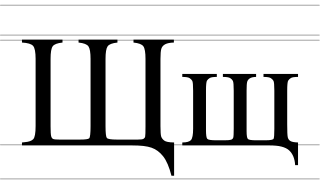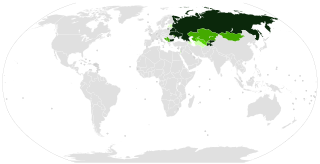
A diacritic is a glyph added to a letter or to a basic glyph. The term derives from the Ancient Greek διακριτικός, from διακρίνω. The word diacritic is a noun, though it is sometimes used in an attributive sense, whereas diacritical is only an adjective. Some diacritics, such as the acute ⟨ó⟩, grave ⟨ò⟩, and circumflex ⟨ô⟩, are often called accents. Diacritics may appear above or below a letter or in some other position such as within the letter or between two letters.

F, or f, is the sixth letter of the Latin alphabet and many modern alphabets influenced by it, including the modern English alphabet and the alphabets of all other modern western European languages. Its name in English is ef, and the plural is efs.
Esperanto is written in a Latin-script alphabet of twenty-eight letters, with upper and lower case. This is supplemented by punctuation marks and by various logograms, such as the digits 0–9, currency signs such as $ € ¥ £ ₷, and mathematical symbols. The creator of Esperanto, L. L. Zamenhof, declared a principle of "one letter, one sound", though this is a general rather than strict guideline.
The circumflex is a diacritic in the Latin and Greek scripts that is also used in the written forms of many languages and in various romanization and transcription schemes. It received its English name from Latin: circumflexus "bent around"—a translation of the Ancient Greek: περισπωμένη.
A caronKARR-ən. or háček, is a diacritic mark placed over certain letters in the orthography of some languages, to indicate a change of the related letter's pronunciation. Typographers tend to use the term caron, while linguists prefer the Czech word háček.

Ĉ or ĉ is a consonant in Esperanto orthography, representing the sound, the pronunciation of the English ⟨ch⟩ as in "cheese".

Ĝ or ĝ is a consonant in Esperanto orthography, representing a voiced postalveolar affricate, and is equivalent to a voiced postalveolar affricate or a voiced retroflex affricate.

Ĥ or ĥ is a letter of some extended Latin alphabets, most prominently a consonant in Esperanto orthography, where it represents a voiceless velar fricative or voiceless uvular fricative. Its name in Esperanto is ĥo, or ĥi in the Kalocsay abecedary.

Ŝ or ŝ is a consonant in Esperanto orthography, representing the sound.

Ŭ or ŭ is a letter in the Belarusian Latin alphabet used since 1840/1845, based on u. It is also used in the Esperanto alphabet, publicly presented in 1887, and formerly in the Romanian alphabet. The accent mark (diacritic) is known as a breve.

The Cyrillic I is a letter used in almost all modern Cyrillic alphabets with the exception of Belarusian.

Che, Cha or Chu is a letter of the Cyrillic script.

Shcha, Shta, or Scha is a letter of the Cyrillic script. In Russian, it represents the long voiceless alveolo-palatal fricative, similar to the pronunciation of ⟨sh⟩ in Welsh-sheep. In Ukrainian and Rusyn, it represents the consonant cluster, something like cash-chest. In Bulgarian, it represents the consonant cluster, like the pronunciation of “scht” in Borscht. Most other non-Slavic languages written in Cyrillic use this letter to spell the few loanwords that use it or foreign names; it is usually pronounced, an approximation of the Russian pronunciation of the letter, and is often omitted when teaching those languages.
Polish orthography is the system of writing the Polish language. The language is written using the Polish alphabet, which derives from the Latin alphabet, but includes some additional letters with diacritics. The orthography is mostly phonetic, or rather phonemic—the written letters correspond in a consistent manner to the sounds, or rather the phonemes, of spoken Polish. For detailed information about the system of phonemes, see Polish phonology.
According to the alphabetic principle, letters and combinations of letters are the symbols used to represent the speech sounds of a language based on systematic and predictable relationships between written letters, symbols, and spoken words. The alphabetic principle is the foundation of any alphabetic writing system. In the education field, it is known as the alphabetic code.

Numerous Cyrillic alphabets are based on the Cyrillic script. The early Cyrillic alphabet was developed in the 9th century AD and replaced the earlier Glagolitic script developed by the theologians Cyril and Methodius. It is the basis of alphabets used in various languages, past and present, Slavic origin, and non-Slavic languages influenced by Russian. As of 2011, around 252 million people in Eurasia use it as the official alphabet for their national languages. About half of them are in Russia. Cyrillic is one of the most-used writing systems in the world. The creator is Saint Clement of Ohrid from the Preslav literary school in the First Bulgarian Empire.
Greek orthography has used a variety of diacritics starting in the Hellenistic period. The more complex polytonic orthography, which includes five diacritics, notates Ancient Greek phonology. The simpler monotonic orthography, introduced in 1982, corresponds to Modern Greek phonology, and requires only two diacritics.
There are two conventional sets ASCII substitutions for the letters in the Esperanto alphabet that have diacritics, as well as a number of graphic work-arounds.












